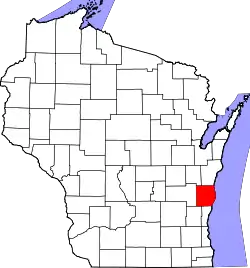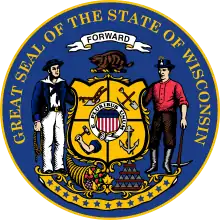Sheboygan, Wisconsin
Sheboygan (/ʃɪˈbɔɪɡən/) is a city in and the county seat of Sheboygan County, Wisconsin, United States.[6] The population was 49,288 at the 2010 census. It is the principal city of the Sheboygan, Wisconsin Metropolitan Statistical Area, which has a population of 115,507. The city is located on the western shore of Lake Michigan at the mouth of the Sheboygan River, about 50 miles (80 kilometers) north of Milwaukee and 64 mi (103 km) south of Green Bay.
Sheboygan | |
|---|---|
| City of Sheboygan | |
 Downtown Sheboygan, with U.S. Bank Building in background | |
 Seal | |
| Nickname(s): | |
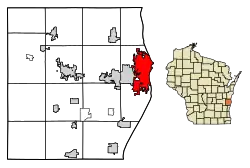 Location of Sheboygan in Sheboygan County, Wisconsin. | |
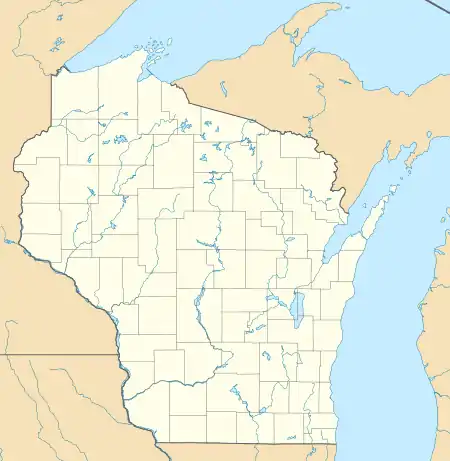 Sheboygan Location within Wisconsin | |
| Coordinates: 43°45′0″N 87°43′30″W | |
| Country | United States |
| State | Wisconsin |
| Counties | Sheboygan |
| Settled | 1780s |
| Incorporated (city) | 1846 |
| Government | |
| • Type | Mayor–council |
| • Body | Common Council |
| • Mayor | Mike Vandersteen (NP) |
| • City Administrator | Todd Wolf |
| • City Clerk | Meredith DeBruin |
| Area | |
| • City | 15.83 sq mi (41.00 km2) |
| • Land | 15.64 sq mi (40.51 km2) |
| • Water | 0.19 sq mi (0.49 km2) |
| Population (2010) | |
| • City | 49,288 |
| • Estimate (2019)[5] | 47,965 |
| • Density | 3,066.82/sq mi (1,184.14/km2) |
| • Metro | 115,507 |
| Time zone | UTC−6 (Central) |
| • Summer (DST) | UTC−5 (Central) |
| ZIP Codes | 53081–53083 |
| Area codes | 920 |
| FIPS code | 55-72975 |
| Website | www |
History
Before its settlement by European Americans, the Sheboygan area was home to Native Americans, including members of the Potawatomi, Chippewa, Ottawa, Winnebago, and Menominee tribes.[7] In the Menominee language, the place is known as Sāpīwāēhekaneh, "at a hearing distance in the woods".[8] The Menominee ceded this land to the United States in the 1836 Treaty of the Cedars, a treaty reached after years of negotiation about how to accommodate the Oneida, Stockbridge-Munsee, and Brothertown peoples who had been removed from New York to Wisconsin.[9] Following the treaty, the land became available for sale to white American settlers. Migrants from New York, Michigan, and New England were among the first white Americans to settle this area in the 1830s, though the French had been present in the region since the 17th century and had intermarried with local people. One 19th century settler remarked: "Nearly all the settlers were from the New England states and New York."[10] Lumbering was the first major industry, as trees were harvested and shipped to eastern markets through the Great Lakes.
Although Sheboygan was officially incorporated in 1846,[11] much of the town had been platted in 1836, when property investors laid out more than one thousand lots.[12]
By 1849, a wave of liberal, middle-class immigration triggered by the revolutions of 1848 had made the community known for its German population. As Major William Williams wrote on June 26, 1849: "Arrived at Sheboigin [sic] on the Wisconsin side, a small town, population purhaps [sic] from 700 to 1000. This is a promising place. There are a great many best class of Germans settling around it. 'Tis all along this Lake so far quite an interesting country."[13] Between 1840 and 1890, Protestant Dutch immigrants also settled in the area,[14] as did Irish refugees fleeing the Great Famine. A neighborhood in northwestern Sheboygan (between Martin Avenue and Alexander Court) was settled by Slovenian immigrants and acquired the name Laibach; it was also known as Vollrath's Division.[15][16][17] In 1887, Sheboygan adopted a sundown town ordinance banning African Americans from living there, according to a local Optimist member's account in 1963, though city leaders denied that any such ordinance was in effect.[18][19]
In the spring of 1898, Sheboygan elected Fred C. Haack and August L. Mohr as aldermen, making them the first two Social Democratic Party candidates to be elected to public office in the United States. Haack had originally been elected in 1897 as a member of the Populist Party but joined the Social Democrats after they organized locally. Haack served as alderman for sixteen years before moving to Milwaukee and being elected as a Socialist alderman there. At the 1932 Socialist Party convention, Haack received recognition as the first Socialist officeholder in America.[20][21]
In the early 20th century, many Catholic Slavs and Lithuanians immigrated to Sheboygan. In the late 20th century, Hmong refugees from Laos and Southeast Asia settled there.
Geography
According to the United States Census Bureau, the city has a total area of 14.11 square miles (36.54 km2), of which, 13.97 square miles (36.18 km2) is land and 0.14 square miles (0.36 km2) is water.[22] It is located at latitude 43°45' north, longitude 87°44' west.
Climate
Sheboygan has a warm-summer humid continental climate[23] typical of Wisconsin. In spite of its position on Lake Michigan there are vast temperature differences between seasons, although it is somewhat moderated compared with areas farther inland.
| Climate data for Sheboygan, Wisconsin | |||||||||||||
|---|---|---|---|---|---|---|---|---|---|---|---|---|---|
| Month | Jan | Feb | Mar | Apr | May | Jun | Jul | Aug | Sep | Oct | Nov | Dec | Year |
| Record high °F (°C) | 62 (17) |
60 (16) |
78 (26) |
86 (30) |
94 (34) |
102 (39) |
107 (42) |
107 (42) |
101 (38) |
86 (30) |
79 (26) |
64 (18) |
107 (42) |
| Average high °F (°C) | 26.7 (−2.9) |
30.6 (−0.8) |
40.6 (4.8) |
53.3 (11.8) |
64.2 (17.9) |
75.3 (24.1) |
80.3 (26.8) |
77.6 (25.3) |
70.3 (21.3) |
57.5 (14.2) |
43.8 (6.6) |
31.0 (−0.6) |
54.3 (12.4) |
| Daily mean °F (°C) | 19.1 (−7.2) |
22.7 (−5.2) |
32.4 (0.2) |
43.6 (6.4) |
53.5 (11.9) |
64.5 (18.1) |
69.4 (20.8) |
67.6 (19.8) |
59.8 (15.4) |
48.3 (9.1) |
35.9 (2.2) |
23.7 (−4.6) |
45.0 (7.2) |
| Average low °F (°C) | 11.5 (−11.4) |
14.7 (−9.6) |
24.2 (−4.3) |
34.0 (1.1) |
42.7 (5.9) |
53.7 (12.1) |
58.4 (14.7) |
57.5 (14.2) |
49.4 (9.7) |
39.1 (3.9) |
27.9 (−2.3) |
16.3 (−8.7) |
35.8 (2.1) |
| Record low °F (°C) | −25 (−32) |
−25 (−32) |
−7 (−22) |
10 (−12) |
27 (−3) |
34 (1) |
43 (6) |
37 (3) |
28 (−2) |
14 (−10) |
−4 (−20) |
−16 (−27) |
−25 (−32) |
| Average precipitation inches (mm) | 1.3 (33) |
1.1 (28) |
1.8 (46) |
3.0 (76) |
3.2 (81) |
3.8 (97) |
3.7 (94) |
3.4 (86) |
3.4 (86) |
2.6 (66) |
2.2 (56) |
1.4 (36) |
30.9 (785) |
| Source: Weatherbase[24] | |||||||||||||
Demographics
| Historical population | |||
|---|---|---|---|
| Census | Pop. | %± | |
| 1860 | 4,262 | — | |
| 1870 | 5,310 | 24.6% | |
| 1880 | 7,314 | 37.7% | |
| 1890 | 16,359 | 123.7% | |
| 1900 | 22,962 | 40.4% | |
| 1910 | 26,398 | 15.0% | |
| 1920 | 30,955 | 17.3% | |
| 1930 | 39,251 | 26.8% | |
| 1940 | 40,638 | 3.5% | |
| 1950 | 42,365 | 4.2% | |
| 1960 | 45,747 | 8.0% | |
| 1970 | 49,246 | 7.6% | |
| 1980 | 48,085 | −2.4% | |
| 1990 | 49,718 | 3.4% | |
| 2000 | 50,792 | 2.2% | |
| 2010 | 49,288 | −3.0% | |
| 2019 (est.) | 47,965 | [5] | −2.7% |
| U.S. Decennial Census[25] | |||
2010 census
As of the census[26] of 2010, there were 49,288 people, 20,308 households, and 12,219 families residing in the city. The population density was 3,528.1 inhabitants per square mile (1,362.2/km2). There were 22,339 housing units at an average density of 1,599.1 per square mile (617.4/km2). The racial makeup of the city was 82.5% White, 1.8% African American, 0.5% Native American, 9.0% Asian, 3.6% from other races, and 2.5% from two or more races. Hispanic or Latino of any race were 9.9% of the population.
There were 20,308 households, of which 30.7% had children under the age of 18 living with them, 43.4% were married couples living together, 11.7% had a female householder with no husband present, 5.1% had a male householder with no wife present, and 39.8% were non-families. Of all households 33.4% were made up of individuals, and 12.1% had someone living alone who was 65 years of age or older. The average household size was 2.38 and the average family size was 3.06.
The median age in the city was 36.2 years. 25.3% of residents were under the age of 18; 8.7% were between the ages of 18 and 24; 27.2% were from 25 to 44; 24.8% were from 45 to 64; and 13.9% were 65 years of age or older. The gender makeup of the city was 49.5% male and 50.5% female.
Hmong community
In 1976, the first three Hmong families settled in Sheboygan with the help of local refugee agencies such as the Grace Episcopal Church and Trinity Lutheran Church. They were refugees from Laos. By 1990, the city had 2,000 residents of Hmong descent. By December 1999, there were around 5,000 Hmong and Hmong American residents in Sheboygan, 65% of whom were under the age of 18.[27]
In 2006, the Sheboygan Hmong Memorial was installed in the lakefront Deland Park to honor Hmong military and civilian contributions to the Secret War in Laos (particularly from 1961-1975). The 2010 U.S. Census showed the number of Hmong citizens to be around 4,100 people, putting it fourth in Wisconsin for Hmong populations.[28]
Arts and culture
Bratwurst Days
Sheboygan County is well known for its bratwurst.[29] The Sheboygan Jaycees sponsor Bratwurst Days, an annual fund-raising festival that includes the Johnsonville World Bratwurst Eating Championship.[30][31]
Dairyland Surf Classic
Sheboygan hosted the annual Dairyland Surf Classic, which was said to be the largest lake surfing competition in the world, from 1988 to 2012.[32][33]
Music
- The Chordettes, 1950s female group
- Morbid Saint, thrash metal band
Points of interest
- Above & Beyond Children's Museum
- Blue Harbor Resort
- Bookworm Gardens
- Ellwood H. May Environmental Park
- General King Park[35]
- John Michael Kohler Arts Center
- Quarry Beach[36]
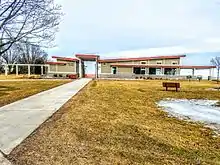
- Mead Public Library
- Plaza 8 (defunct)
- Sheboygan County Historical Museum
- Sheboygan Hmong Memorial
- Sheboygan Indian Mound Park
- Sheboygan Municipal Auditorium and Armory
- Stefanie H. Weill Center for the Performing Arts
In April 1894, the schooner Lottie Cooper wrecked just off Sheboygan in a gale.[37] The wreckage was found buried in the harbor during the construction of the Harbor Centre Marina and is now on display in Deland Park, on Sheboygan's lakefront. The free display is the only one of its kind on the Great Lakes.[38]
Parks and recreation

Trails
The city has one trail along the Highway 23 corridor leading to the Old Plank Road Trail to the west of Sheboygan that uses dedicated paths and bike lanes. A 2013 project created a north-south trail using the former Chicago & Northwestern Railroad right-of-way known as the "Shoreline 400", with future expansion planned. A 2016 project added a trail along the Taylor Drive corridor, and improvements to the south to allow connection to the Ozaukee Interurban Trail are proposed for a future date.
Government
Local government

Sheboygan has a Mayor–Council form of government. The full-time mayor is elected by general election for a term of four years, with no term limits and an official non-partisan position. The Common Council consists of ten alderpersons representing the city's ten aldermanic districts with a council president and vice-president presiding over them. [39] A City Administrator oversees the day-to-day administration of the city and is appointed by the Common Council.
Sheboygan's 1916-built City Hall was remodeled throughout 2018 and into 2019, being re-dedicated on September 3, 2019 with a new north frontage becoming the building's new main entrance and making the building's vintage three-story staircase its most prominent feature within a new atrium.[40]
The Sheboygan Police Department is the law enforcement agency in the city. Civil and criminal law cases are heard in the Sheboygan County Circuit Court, with municipal citations for Sheboygan and Kohler handled through the city's municipal court within the police headquarters building.[41] The Sheboygan Fire Department provides fire suppression and emergency medical services, operating out of five fire stations throughout the city.
State and federal representation
Sheboygan is represented in the Wisconsin State Assembly as part of both the 26th (Terry Katsma, R-Oostburg) and 27th (Tyler Vorpagel, R-Plymouth) districts, whose boundaries split the city along Geele Ave. from the west until 18th St., then Superior Ave. from 18th St. to Lake Michigan. The city is also represented in the State Senate as part of the 9th district (Devin LeMahieu, R-Oostburg).
Sheboygan is in the 6th congressional district of Wisconsin, which is represented by Republican congressperson Glenn Grothman.
Education
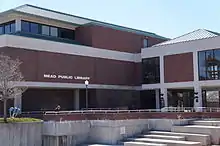
Sheboygan public schools are administered by the Sheboygan Area School District.
High schools
High schools within the city include:
- Sheboygan North High School
- Sheboygan South High School
- Sheboygan Area Lutheran High School
- Sheboygan County Christian High School
- George D. Warriner High School
- Étude High School
- Sheboygan Central High School
The school district was the first in Wisconsin to operate an FM radio station, WSHS (91.7). Since 1996, Sheboygan has had a high school program, Rockets for Schools,[42] where students build and launch 8-and-20-foot-tall (2.4 and 6.1 m) rockets.
Colleges
- University of Wisconsin–Green Bay Sheboygan Campus
- Lakeland University
- Lakeshore Technical College (satellite campus)
Media
The city's daily newspaper is Gannett's The Sheboygan Press, which has been published since 1907. The free papers The Sheboygan Sun and The Beacon are mailed weekly to area residents and feature classified ads and other local content, with the equivalent Gannett-owned Shoreline Chronicle door-delivered and with the Wednesday Press.
The city is served by television and radio stations in Green Bay and Milwaukee. A. C. Nielsen's television division places Sheboygan within the Milwaukee market, although Green Bay stations also report news, events, and weather warnings pertaining to Sheboygan and target the city with advertising.
Nielsen Audio places Sheboygan and Sheboygan County within one radio market, and several stations serve the area. Midwest Communications owns four stations within the county, including talk station WHBL (1330, with a translator station at 101.5 FM serving Sheboygan, Kohler and Sheboygan Falls); country station WBFM (93.7); CHR/Top 40 WXER (104.5 from Plymouth, with a translator at 96.1 FM in Sheboygan); and active rock Sheboygan Falls-licensed WHBZ (106.5). Another CHR station, WCLB (950, translated on 107.3) also serves the city, along with the Sheboygan Area School District's WSHS (91.7), a member of the Wisconsin Public Radio Ideas Network, and Plymouth's WGXI (1420, translated on 98.5), a standards and Soft/Gold AC station.
Various religious stations originating from Milwaukee and north of Green Bay and a translator for Kiel's WSTM (91.3), and NOAA Weather Radio station WWG91 broadcast from several towers in the city. WYVM acts as a full-power relay of Suring's WRVN (102.7), which has a religious teaching format.
The city is served by Spectrum and AT&T U-verse, with public-access television cable TV programming provided to both systems from "WSCS". The city at one time had a television station, WPVS-LP, which went off the air following the digital switchover and has since moved to Milwaukee; WHBL also attempted to establish a television sister station several times, without success.[43]
Infrastructure
Transportation
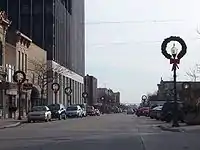
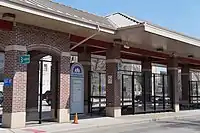
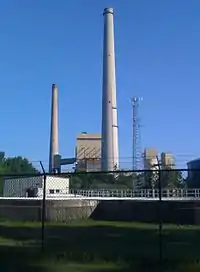
Roads
Interstate 43 is the primary north-south transportation route into Sheboygan, and forms the west boundary of the city. U.S. Route 141 was the primary north-south route into Sheboygan before Interstate 43 was built, and its former route is a major north-south route through the center of the city that is referred to as Calumet Drive coming into the city from the north, and South Business Drive/Sauk Trail Road from the south; between Superior and Georgia Avenues, the highway is known as 14th Street. Four-lane Highway 23 is the primary west route into the city, and leads into the city up to North 25th Street as a freeway. Other state highways in the city include Highway 42, Highway 28, which both run mostly along the former inner-city routing of U.S. 141. Secondary county highways include County Trunk Highway DL and the decommissioned CTH LS to the north; County Trunk Highways J, O, PP, and EE to the west; and CTH KK to the south.
For addressing purposes, the city's north-south zero point is Pennsylvania Avenue (increasing from 500 past that line in both directions), while west addressing zeroes out at the extreme eastern point of Superior Avenue at Lake Michigan (Sheboygan and Sheboygan County have no east addresses, and the little land existing northeast of that point stretches out the six '100 blocks' northward with xx50-xx90 numbers not otherwise used in most other addresses in Sheboygan).
Commuter bus transit
Shoreline Metro provides public bus transit throughout the city, as well as in Kohler and Sheboygan Falls. All routes depart from the Metro Center, more commonly known as the "Transfer Point" located in the downtown.
Jefferson Lines and Indian Trails serve Sheboygan at the Metro Center, providing transportation to Milwaukee (and an Amtrak Thruway connection to the Milwaukee Intermodal Station) and Green Bay.
Rail
Historically the city was connected to Milwaukee, Chicago and Green Bay via the Milwaukee Interurban Lines, the Chicago & North Western Railroad and the Milwaukee Road. These railroads' passenger services were abandoned during the mid-20th century but in 2008 the Wisconsin Department of Transportation proposed to reestablish passenger service to Milwaukee and Green Bay via Fond du Lac and the cities along Lake Winnebago's west shore, though political complications in the 2010s have since mothballed rail expansion in Wisconsin.[44]
Airport
Sheboygan is served by the Sheboygan County Memorial Airport (KSBM), which is located three miles northwest of the city but there are no commercial airlines that fly into the airport.
Water
Sheboygan is bounded on the east by Lake Michigan. The city has no active port in the 21st century. Blue Harbor Resort is located on a peninsula between the lake and the Sheboygan River's last bend. This site was formerly used as the headquarters of the C. Reiss Coal Company (now a Koch Industries division). It was their base of operations for ships to load and unload coal for delivery along the peninsula.
The Sheboygan River passes through the city, but dams in Sheboygan Falls prevent navigation upriver. Tall-masted boats are confined to the river downstream of the Pennsylvania Avenue bridge. Commercial charter fishing boats dock near the mouth of the river.
Hospitals

- Aurora Sheboygan Memorial Medical Center
- St. Nicholas Hospital
In the early 2020s, Aurora Health Care will open a replacement hospital for Aurora Sheboygan Memorial Medical Center on Union Avenue east of I-43 on Kohler village land north of the Acuity Insurance campus otherwise inaccessible from Kohler proper itself without going through Sheboygan.[45]
Notable people
- Peter Bartzen, Wisconsin State Representative
- James Baumgart, Wisconsin state senator
- Theodore Benfey, Wisconsin state senator
- Thomas M. Blackstock, politician and businessman
- Archie Bleyer, music director[46]
- Helen Boatwright, opera singer and educator
- Vernon R. Boeckmann, Wisconsin State Representative and sheriff
- Ray Buivid, football player
- Charles Burhop, politician
- Elijah Fox Cook, Wisconsin state senator
- The Chordettes, singing quartet
- Valentine Detling, Wisconsin State Representative and businessman
- Sam Dekker, professional basketball player
- Ambrose Delos DeLand, Wisconsin legislator
- Fred A. Dennett, Wisconsin state senator
- John M. Detling, Wisconsin State Representative
- Theodore Dieckmann, Wisconsin legislator
- John Dittrich, NFL player[47]
- Jerry Donohue, major contributor toward DNA identification
- Bill Dwyre, editor and columnist, Los Angeles Times
- John W. Eber, Speaker of the Wisconsin State Assembly
- Simon Gillen, Wisconsin State Representative and jurist
- Bernard O. Gruenke, artist
- Fred C. Haack, one of two first Socialist candidates (with August Mohr) elected to office in America
- Lorenzo D. Harvey, Superintendent of Public Instruction of Wisconsin
- Timothy Hasenstein, painter
- Joe Hauser, Major League Baseball player[48]
- Herman Heinecke, Wisconsin state assembly
- Henry A. Hillemann, Wisconsin State Representative and lawyer
- Harrison Carroll Hobart, Union Army general
- William E. Hoehle, Wisconsin State Representative
- Curt W. Janke, Wisconsin State Representative
- Marvin John Jensen, U.S. Navy admiral
- John H. Jones, Wisconsin state senator
- Jacob Jung, Wisconsin State Representative and businessman
- William G. Kaufmann, politician and businessman
- Edward J. Kempf, Wisconsin State Representative
- Ernest Keppler, politician and jurist
- John J. Koepsell, Wisconsin State Representative and businessman
- John Michael Kohler, industrialist, founder of Kohler Company and mayor of Sheboygan
- Terry Jodok Kohler, industrialist
- Walter J. Kohler, Jr., Governor of Wisconsin
- Walter J. Kohler, Sr., Governor of Wisconsin
- Conrad Krez, Union Army general, Wisconsin State Representative
- Frederick W. Krez, Wisconsin State Representative
- Eloise Kummer, actress
- Wesley Lau, actor
- Joe Leibham, lobbyist and former Wisconsin State Senator
- Debbie Lesko, U.S. Representative from Arizona
- Frank J. Lingelbach, Wisconsin State Representative
- Rick Majerus, NCAA and NBA basketball coach
- Anthony Martin, escape artist
- Jackie Mason, comedian and actor
- Pat Matzdorf, high jump world record holder
- Don McNeill, radio host of "The Breakfast Club"[49]
- Doxie Moore, former NBA head coach for the Sheboygan Red Skins
- Charles E. Morris, Wisconsin State Representative
- Martha Nause, golfer
- Otto C. Neumeister, Wisconsin State Representative
- Fred E. Nuernberg, Wisconsin State Representative
- William J. Nuss, Wisconsin State Representative
- Carl Otte, Wisconsin legislator
- Benjamin Hoskins Paddock, father of Stephen Paddock, perpetrator of the 2017 Las Vegas shooting[50]
- Dennis T. Phalen, Wisconsin state senator
- Roy Pirrung, marathon runner and motivational speaker
- Calvin Potter, Wisconsin state senator
- Valentine P. Rath, Wisconsin State Representative
- Henry Otto Reinnoldt, Wisconsin State Representative
- Wilbur M. Root, Wisconsin State Representative
- George Sauer, Jr., NFL player[51]
- John Schneider, Jr., Wisconsin State Representative
- Bill Schroeder, football player (wide receiver)
- Bill Schroeder, professional football player (halfback)
- Carl Schuette, NFL player[52]
- David N. Senty, U.S. Air Force Major General
- James McMillan Shafter, jurist and legislator
- E. E. Smith, science fiction author
- Horatio N. Smith, Wisconsin state senator
- Ernest A. Sonnemann, Wisconsin State Representative
- Adolphus Frederic St. Sure, judge
- David Taylor, judge
- Joseph M. Theisen, Wisconsin State Representative
- Michelle Tuzee, ABC news anchor, Los Angeles
- William Te Winkle, Wisconsin state senator
- Edward Voigt, U.S. Representative
- Jacob Vollrath, industrialist
- Joseph Wedig, Wisconsin State Representative
- Gustavis A. Willard, Wisconsin State Representative
- George W. Wolff, Wisconsin State Representative and senator
- Carl Zillier, Wisconsin State Representative
Images
 Wreck of the Lottie Cooper
Wreck of the Lottie Cooper_(retouched).jpg.webp) 8th Street Sheboygan, probably in the 1870s, featuring a man on a dead horse[53]
8th Street Sheboygan, probably in the 1870s, featuring a man on a dead horse[53] Sheboygan Post Office, a registered historic place (RHP)
Sheboygan Post Office, a registered historic place (RHP)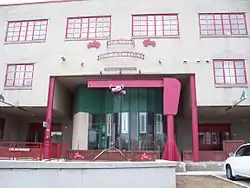 Garton Toy Factory, a RHP
Garton Toy Factory, a RHP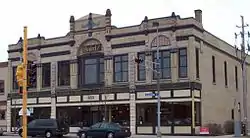 Jung Carriage Building, a RHP
Jung Carriage Building, a RHP Sheboygan Theater, a RHP
Sheboygan Theater, a RHP Downtown Sheboygan
Downtown Sheboygan
In popular culture
- The Creature That Ate Sheboygan is a science fiction board game released in 1979 by Simulations Publications (SPI).
- In the 1990 Christmas classic movie, Home Alone, Gus Polinski, or The Polka King, mentions that his polka band is well-liked in Sheboygan, as they sold 623 records there.[54]
- In Season 1, Episode 6, of 'That '70s Show, Bob references Sheboygan as the reason why his mailbox got stolen, saying, "The evil spilling over from Sheboygan."[55]
- In its Park Roads ad, Allstate pitchman Dennis Haysbert mentions Sheboygan's Park Avenue while showing a staged downtown setting in Richmond, British Columbia of the intersection of 2nd Avenue & Moncton Street, with artificial street signs representing Park Avenue. The neighborhood represented in the ad is actually a residential/parkland neighborhood.[56]
Recognition
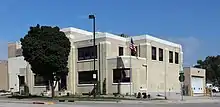
- Sheboygan was recognized by Reader's Digest as "The Best Place to Raise a Family" in the United States in 1997.[57]
- Sheboygan was recognized by the Wisconsin Chamber of Commerce as the #10 Best Place to Live in Wisconsin in 2019.[58] Considerations were given to educational quality, work commute, and housing costs.
Sister cities
Sheboygan's sister cities are:
 Esslingen am Neckar, Baden-Württemberg, Germany
Esslingen am Neckar, Baden-Württemberg, Germany Tsubame, Niigata, Japan
Tsubame, Niigata, Japan
Sheboygan has student exchanges with Esslingen and has had student exchanges with Tsubame in the past.[59]
See also
- Sheboygan Red Skins, an early professional basketball franchise of the NBA
- The Creature That Ate Sheboygan
References
- "Surfing in Sheboygan: The Malibu of the Midwest". Travel Wisconsin. Retrieved July 2, 2020.
- "Brat Capital of the World". Sheboygan County Chamber Tourism. Retrieved January 22, 2015.
- Hampson, Rich. "Welcome to City of Cheese, Chairs, Children and Churches". Associated Press.
- "2019 U.S. Gazetteer Files". United States Census Bureau. Retrieved August 7, 2020.
- "Population and Housing Unit Estimates". United States Census Bureau. May 24, 2020. Retrieved May 27, 2020.
- "Find a County". National Association of Counties. Retrieved June 7, 2011.
- Buchanan, Gustave (1944). Historic Sheboygan County. p. 37.
- Hoffman, Mike. "Menominee Place Names in Wisconsin". The Menominee Clans Story. Retrieved October 6, 2018.
- "Menominee Treaties and Treaty Rights - Indian Country Wisconsin". www.mpm.edu. Retrieved March 1, 2019.
- Carl Zillier, ed. (1912). History of Sheboygan County, Wisconsin, Past and Present. Vol. 1. Chicago: S. J. Clarke. p. 129.
- J. E. Leberman (1946). One Hundred Years of Sheboygan, 1846–1946. Sheboygan, Wis.
- "Speculation! Speculation!". Rutland Herald. May 17, 1836.
- William Williams. "Major William Williams' Journal of a Trip to Iowa in 1849", Annals of Iowa vol. 12, no. 4 (1920): 242-281.
- "Wisconsin's Cultural Resource Study Units". Wisconsin Historical Society. Retrieved April 13, 2014.
- "Everybody Is Invited". The Sheboygan Press. Sheboygan, WI. August 29, 1914. p. 5. Retrieved December 17, 2020 – via Newspapers.com.

- "Get a Spanferkel". The Sheboygan Press. Sheboygan, WI. October 9, 1915. p. 5. Retrieved December 17, 2020 – via Newspapers.com.

- "Research Center Uncovers the Mystery of Laibach". The Sheboygan Press. Sheboygan, WI. November 25, 2017. p. A1. Retrieved December 17, 2020 – via Newspapers.com.

- "City Must Prepare To Welcome Negroes Into Community: Hildahl". The Sheboygan Press. Sheboygan, Wisconsin. September 27, 1963. p. 2 – via Newspapers.com.
One Optimist claimed that loan requirements of the Federal Home and Housing Agency will force Sheboygan to sell homes to Negroes 'and when that happens the lid is going to blow off.' The same Optimist asserted that present city officials deny that Sheboygan has an ordinance preventing Negroes from living in Sheboygan. But, he claimed, Sheboygan adopted such an ordinance in 1887 – 'that no Negroes will be housed in Sheboygan – and it is still on the books.'
- Jozwiak, Miller (July 11, 2016). "From 'Go Home' to 'Welcome Home' for local man". The Sheboygan Press. Sheboygan, Wisconsin. pp. 1A–2A – via Newspapers.com.
[James] Loewen's testimonies are remembered, secondary accounts. The Sheboygan Press archives also tell a story of discriminatory local discourse and policy. The very rumor of a sundown ordinance prompted then-Mayor John Bolgert in 1959 to outright deny that Sheboygan had any sundown laws. He cited as proof that black people were able to live in the city when they were playing baseball for the local minor league team. The same story reported a local pastor as saying there was no prejudice toward black people because there were none here.
- Elmer A. Beck (1982). The Sewer Socialists. Fennimore, Wis.: Westburg Associates. p. 20.
- "Former Sheboygan Alderman is Laid to Rest". Sheboygan Press. August 4, 1944.
- "US Gazetteer files 2010". United States Census Bureau. Archived from the original on January 24, 2012. Retrieved November 18, 2012.
- "Sheboygan, Wisconsin climate summary". Weatherbase. Retrieved August 9, 2015.
- "Sheboygan, Wisconsin Temperature Averages". Retrieved August 9, 2015.
- "Census of Population and Housing". Census.gov. Retrieved June 4, 2015.
- "U.S. Census website". United States Census Bureau. Retrieved November 18, 2012.
- Kaiser, Robert L. "After 25 Years In U.S., Hmong Still Feel Isolated", Chicago Tribune, December 27, 1999. Retrieved April 14, 2012.
- "History program spotlights Sheboygan's Hmong community". Sheboygan Press Media. Retrieved January 21, 2017.
- "Sheboygan County Registrar of Deeds".
- "History". Sheboygan County Chamber of Commerce.
- LaRose, Eric (March 1, 2006). "City asked to abolish brat-eating contest". The Sheboygan Press. Archived from the original on June 12, 2006.
- "Dairyland Surf Classic". Wisconsin Department of Tourism. Archived from the original on December 10, 2007. Retrieved October 16, 2007.
- "The world's most surprising surf spots". USA Today. Retrieved November 30, 2020.
- Marley, Patrick (November 28, 2005). "Bill envisions liftoff for Sheboygan". Milwaukee Journal Sentinel. Archived from the original on December 19, 2006. Retrieved January 11, 2007.
- "Parks and Shelters". City of Sheboygan.
- "Quarry Beach | Travel Wisconsin". TravelWisconsin. Retrieved August 29, 2019.
- "Significant Chronology for the Lottie Cooper".
- "Lottie Cooper (1876)". Wisconsin Shipwrecks. Wisconsin Historical Society. Retrieved May 14, 2018.
- Sheboygan Charter Ord. No. 1-15-16.
- Bennett, McLean (June 7, 2018). "Sheboygan City Hall $10.5 million renovation a long time coming". Sheboygan Press. Retrieved July 7, 2018.
- "Municipal Court". City of Sheboygan. Retrieved February 11, 2018.
- "Rockets for Schools".
- FCC Internet Services Staff. "FCC record of deleted station WHBL-TV". Licensing.fcc.gov. Retrieved August 27, 2013.
- Titletown Corridor – Milwaukee to Green Bay
- "Aurora Begins Process to Build Replacement Hospital, Outpatient Surgery Center and Medical Office Building in Eastern Sheboygan County" (Press release). Aurora Health Care. April 11, 2017. Retrieved December 20, 2017.
- "Archie Bleyer, 79, Music Director, Dies". The New York Times, March 21, 1989.
- "John Dittrich NFL & AFL Football Statistics". Pro-Football-Reference.com. May 7, 1933. Retrieved August 27, 2013.
- "Joe Hauser Statistics and History". Baseball-Reference.com. Retrieved August 27, 2013.
- Knot, Eldon (August 5, 1996). "Breakfast Club' host Don McNeill dies Radio legend, who grew up in Sheboygan, once was fired for seeking $3 raise at Milwaukee station". Milwaukee Journal Sentinel. Associated Press.
- "Las Vegas gunman's father born in Sheboygan, on FBI Most Wanted List in '60s". Milwaukee Journal Sentinel. Retrieved October 3, 2017.
- "George Sauer NFL & AFL Football Statistics". Pro-Football-Reference.com. November 10, 1943. Retrieved August 27, 2013.
- "Carl Schuette NFL Football Statistics". Pro-Football-Reference.com. Retrieved August 27, 2013.
- Colleen Fitzpatrick, "The dead horse investigation – update", Identifinders, November 26, 2010.
- [https://www.youtube.com/watch?v=E89cRvEC0J0&list=PLhRlQwivYbG821NbpiB6QSR-5SjJEuTO8&index=30[
- Park Road America :30 | Allstate Insurance
- "The Sheboygan Press". Gannett.
- www.sheboyganwi.gov http://www.sheboyganwi.gov/sheboygan-named-one-of-wisconsins-best-places-to-live/. Retrieved August 29, 2019. Missing or empty
|title=(help) - "Hungry still get their fill at Taste of Sheboygan". Sheboygan Press. March 5, 2007. Retrieved April 11, 2007.
Further reading
- Legacies of Firefighting: A History of the Sheboygan Fire Department, 1846–1998. Sheboygan, Wis.: Sheboygan Fire Department History Book Committee, 1998.
- Sheboygan. Charleston, S.C: Arcadia Pub, 2012.
External links
| Wikimedia Commons has media related to Sheboygan, Wisconsin. |
| Wikisource has the text of the 1921 Collier's Encyclopedia article Sheboygan. |
- City of Sheboygan
- Sheboygan County Chamber of Commerce
- Sanborn fire insurance maps: 1884 1887 1891 1903
